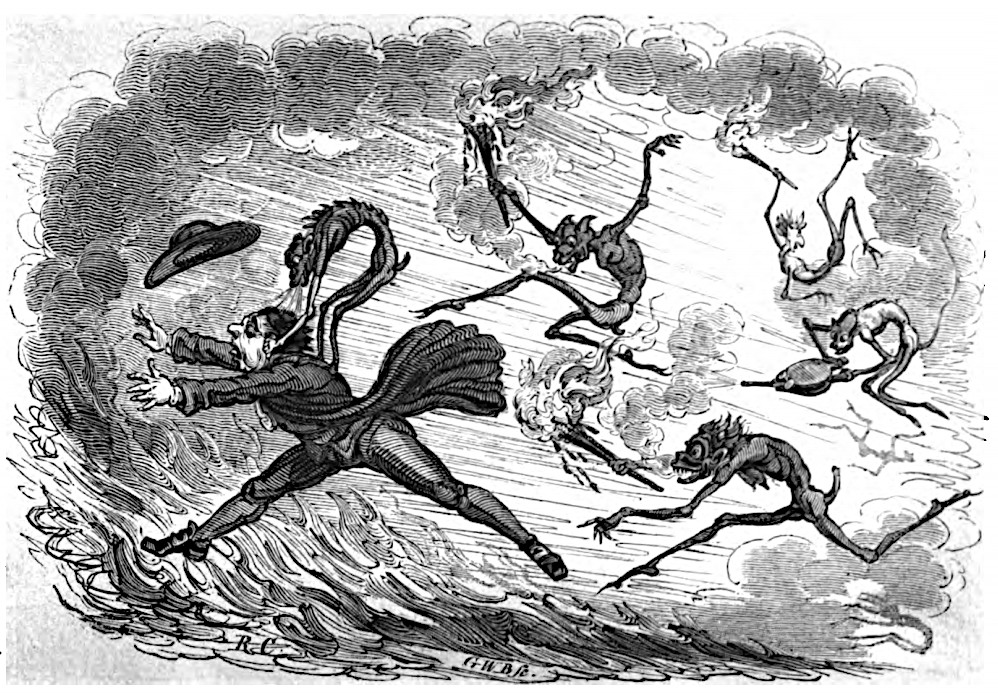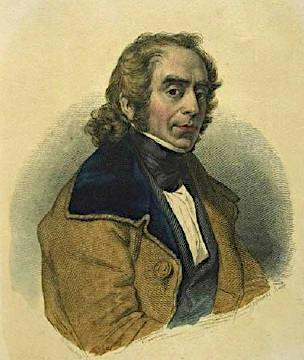
USC mathematician Solomon Golomb offered this puzzle in his column, “Golomb’s Gambits,” in Johns Hopkins Magazine. How can you dissect this figure into four congruent pieces?

USC mathematician Solomon Golomb offered this puzzle in his column, “Golomb’s Gambits,” in Johns Hopkins Magazine. How can you dissect this figure into four congruent pieces?

A striking tale from the 18th century: It’s said that around 1687 a group of English mariners on the Italian coast were surprised to see “two men run by us with amazing swiftness”:
Captain Barnaby says, ‘Lord bless me, the foremost man looks like next door neighbour, old Booty;’ but said he did not know the other behind. Booty was dressed in grey clothes, and the one behind him in black; we saw them run into the burning mountain in the midst of the flames! on which we heard a terrible noise, too horrible to be described.
When they returned to Gravesend, Captain Barnaby’s wife said, “My dear, I have got some news to tell you; old Booty is dead.” Barnaby swore an oath and said, “We all saw him run into Hell!”
As the story goes, when word of this allegation reached Booty’s widow, she sued Barnaby for a thousand pounds. The punchline is that Booty’s appearance on the volcano was shown to have occurred within two minutes of his death, and when his coat was exhibited in the courtroom, 12 sailors swore that its buttons matched those of the fleeing man.
The Judge then said, ‘Lord grant I may never see the sight that you have seen; one, two, or three may be mistaken, but twenty or thirty cannot.’ So the widow lost her cause.
According to folklorist Jeremy Harte, this story appeared in print at least 19 times between the 1770s and the 1830s. It seems to have started among the dockyards of the lower Thames, where in one early version Booty was an unscrupulous contractor who had supplied the navy with adulterated beer — and his damnation was “a matter of just retribution for the sin he had committed.”
(Jeremy Harte, “Into the Burning Mountain: Legend, Literature, and Law in Booty v. Barnaby,” Folklore 125:3 [December 2014], 322-338.)
A problem from Canada’s 2003 Hypatia contest:
Xavier and Yolanda are playing a game. They begin with two piles of three coins each and take turns; on each turn a player removes one or more coins from any one pile. The winner is the player who takes the very last coin. Xavier always goes first, but Yolanda has a strategy that ensures that she will always win. What is it?
John Smith escaped execution three times. Convicted of housebreaking in 1705, he was hanged at the Tyburn gallows for a quarter of an hour before the people called for a reprieve and he was cut down.
When he had perfectly recovered his senses he was asked what were his feelings at the time of execution; to which he repeatedly replied, in substance, as follows. When he was turned off, he for some time was sensible of very great pain, occasioned by the weight of his body, and felt his spirits in a strange commotion, violently pressing upwards. That having forced their way to his head, he as it were saw a great blaze, or glaring light, which seemed to go out at his eyes with a flash, and then he lost all sense of pain. That after he was cut down, and began to come to himself, the blood and spirits, forcing themselves into their former channels, put him, by a sort of pricking or shooting, to such intolerable pain that he could have wished those hanged who had cut him down.
He returned to housebreaking on his release in 1706, but his strange luck continued: On his second indictment some difficulties in the case induced a panel of judges to set him free, and on his third the prosecutor died before the day of the trial.
The streak ended in 1727, when he was convicted of stealing a padlock and sentenced to transportation. He pleaded for corporal punishment instead but was sent to Virginia that July.

In 1853, a lady at a social dinner challenged explorer Jacques Arago to compose an account of his circumnavigation without using the letter A.
Allegedly she thanked him without using the letter C.

“Whoopee! Man, that may have been a small one for Neil, but that’s a long one for me!” — Pete Conrad, after becoming the third human to set foot on the moon

Suppose … for a moment, all existing space to be bounded, and that a man runs forward to the uttermost borders, and stands upon the last verge of things, and then hurls forward a winged javelin,– suppose you that the dart, when hurled by the vivid force, shall take its way to the point the darter aimed at, or that something will take its stand in the path of its flight, and arrest it? For one or other of these things must happen. There is a dilemma here that you never can escape from.
— Lucretius, De rerum natura

University of Cambridge mathematician Matthew Scroggs has post his annual Christmas puzzle: Behind each day in an advent calendar lies a puzzle with a three-digit answer. Combined, the answers reveal a series of compass directions that lead to Santa’s house. Ten randomly selected people who solve all the puzzles and find Santa’s house will receive prizes. More info here.

In 1903 Robert Falcon Scott made an odd discovery in the Dry Valleys of Antarctica:
[W]e have seen no living thing, not even a moss or a lichen; all that we did find, far inland amongst the moraine heaps, was the skeleton of a Weddell seal, and how that came there is beyond guessing. It is certainly a valley of the dead; even the great glacier which once pushed through it has withered away.
It appears that periodically a crabeater, Weddell, or leopard seal finds its way inland from McMurdo Sound and the Ross Sea and perishes in the punishing environment of the dry valleys, an extreme desert. There the dry conditions mummify its corpse, preserving it in some cases for thousands of years.
Some mummies have been found as much as 41 miles inland and as high as 5,900 feet above sea level, reflecting a heroic effort to find the sea. Mercifully the phenomenon is relatively rare, with a seal becoming lost only once every 4 to 8 years.
“I think it is all right to argue sometimes.”
“I disagree!”
(From Raymond Smullyan.)